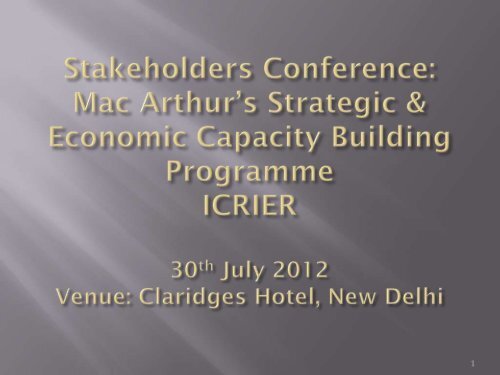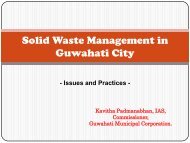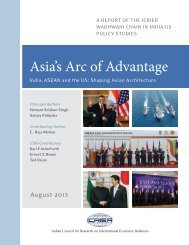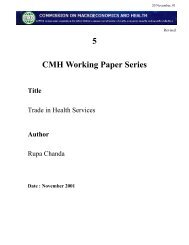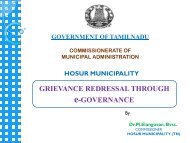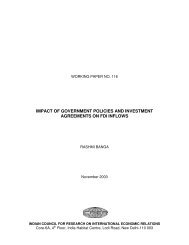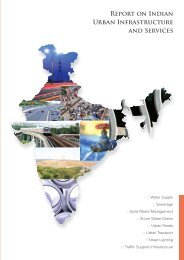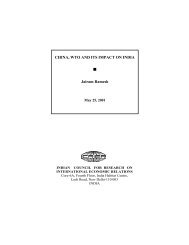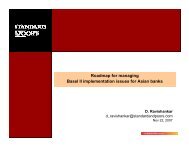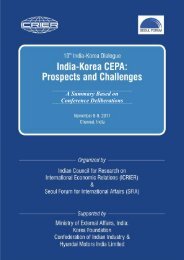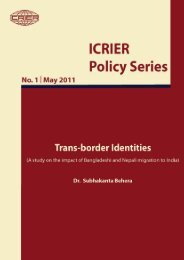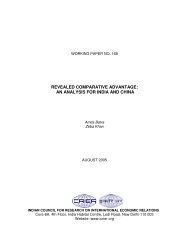Download Presentation - icrier
Download Presentation - icrier
Download Presentation - icrier
Create successful ePaper yourself
Turn your PDF publications into a flip-book with our unique Google optimized e-Paper software.
By<br />
Ashish Nath<br />
Department of Economics<br />
Tripura University
• a ‘special criteria state’ due to its backwardness and<br />
geographical isolation.<br />
• NSDP at current prices increased from ₹8169.69 crores in<br />
2004-05 to to ₹14,604.27 crores in 2009-10 (A).<br />
• The per capita income at current prices of the State rose from<br />
₹24,394 in 2004-05 to Rs.35,799 in 2009-10(A).<br />
• The Human Development Index for Tripura for the year 2001<br />
is 0.59.<br />
• The literacy rate in the state is 73% and the investment in<br />
R&D is almost zero.<br />
• There are few small scale industries in Tripura (0.23% of<br />
India and 7.7% of NER) but there is no large scale industry.<br />
• Major SSIs flourished in Tripura are tea, food processing,<br />
handloom and handicrafts, rubber and bamboo.<br />
• The FDI equity inflows from April’ 2000 to December’ 2010 to<br />
the seven states of north east India is ₹280 crores, which is<br />
0.1% of the total inflows in terms of US $.
Government of Tripura – Budget<br />
(₹ in crores)<br />
2007-08 2008-09 2009-10 2010-11<br />
BE<br />
2010-11<br />
RE<br />
2011-12 BE<br />
Revenue Receipts 3698.34 4198.38 4401.35 5512.54 5386..50 5989.35<br />
i) State’s own Tax Revenue 370.70 451.38 527.01 667.05 626.45 783.45<br />
i) State’s own Non-tax revenue 115.41 133.03 125.40 190.20 130.55 137.13<br />
i) State’s share of Union Taxes and<br />
Duties<br />
650.62 735.00 706.34 1069.00 1069.00 1283.60<br />
i) Other Grants from Central<br />
Government<br />
2561.61 2878.97 3042.60 3586.29 3560.50 3785.17<br />
Capital Receipts 110.54 238.25 787.80 734.69 631.00 730.00<br />
i) Recovery of loans 3.27 3.00 3.55 3.00 3.00 3.00<br />
i) Borrowings 50.09 223.25 493.81 526.69 523.00 577.00<br />
i) Loans from Public Account 57.18 12.00 290.44 205.00 105.00 150.00<br />
Total Receipts 3808.88 4436.63 5189.15 6247.23 6017.50 6719.35<br />
10
Export and Import - Bangladesh and India/Tripura (value in ₹ lakhs)<br />
Export from<br />
Export<br />
Import from Bangladesh by<br />
Trade balance<br />
Trade balance<br />
Yearwise<br />
India to<br />
from<br />
between India<br />
between<br />
Tripura to<br />
& Bangladesh<br />
Tripura &<br />
Bangladesh<br />
Bangladesh India Tripura - -<br />
2007-2008 11,74,321.30 149.061 103,468.16 13,433.693 10,70,853.14 -13284.632<br />
2008-2009 11,31,721.47 30.828 141,846.07 12,916.055 9,89,875.40 -12885.227<br />
2009-2010 11,50,106.83 41.291 120,528.14 16,288.971 10,29,578.69 -16247.680<br />
2010-2011<br />
16,38,536.39<br />
170.535<br />
203,138.64<br />
256,00.743 143,539,7.75 -25430.208<br />
12
• Bangladesh trade balance with India is always<br />
negative whereas that of with Tripura is positive,<br />
• The negative trade balance between Tripura and<br />
Bangladesh increased over the years,<br />
• the value of export from Tripura to Bangladesh is<br />
about 0.01% of the total exports from India during<br />
2010-2011,<br />
• the value of import by Tripura from Bangladesh is<br />
about 12.56% of the total imports by India during<br />
2010-2011,<br />
• The value of exports from Tripura to Bangladesh is<br />
less than one percent of the value of imports from<br />
Bangladesh to Tripura during 2010-2011.
• There are 35 border trade points between Bangladesh<br />
and North Eastern states of Tripura, Assam, Mizoram<br />
and Meghalaya, the states which share geographical<br />
boundary with Bangladesh.<br />
• The straight line distance between Agartala and<br />
Kolkata is only about 350 Kms and many large cities of<br />
Bangladesh are within 150 kms from the towns in<br />
Tripura (Agartala-Dhaka: 150 km, Agartala-<br />
Brahmanbaria: 25 km, Sabroom-Chittagong: 75 km,<br />
Sonamura-Comilla: 11 km, Kailashahar-Sylhet: 90 km).<br />
• All the eight districts of Tripura share boundaries with<br />
Bangladesh as seen from the map.<br />
• The people of Bangladesh and Tripura always share<br />
relationship because of ethnic, social and cultural<br />
linkages.
• Formal Trade<br />
• Informal Trade
• The structure and composition of exports and imports<br />
between Tripura and Bangladesh.<br />
• The various border (both formal and informal) trade points<br />
between Tripura and Bangladesh.<br />
• The type and areas of investment by Bangladesh?<br />
• What are the barriers of FDI from Bangladesh?<br />
• What are the trade barriers for investment from Bangladesh<br />
to Tripura?<br />
• Are there are any non-trade barriers between the two<br />
countries?
• To examine the nature of informal trade between<br />
the Tripura and Bangladesh?<br />
• Are the same goods being traded through the<br />
formal and informal channels?<br />
• What will be the impact of trade and investment<br />
with Bangladesh on state income and employment<br />
of Tripura?<br />
• What is the role of governments and/or<br />
institutions towards the trade between Tripura and<br />
Bangladesh?<br />
• What measures should be adopted by Tripura, to<br />
increase its competitiveness?<br />
• What is the implication of trade between Tripura<br />
and Bangladesh on India especially Tripura and<br />
North Eastern region?
Tripura has only road connectivity with<br />
Bangladesh. As such, trade with Bangladesh is done<br />
only through land custom stations. There are seven<br />
Land Custom Centres (LCS) in Tripura. They are –<br />
• Muhurighat (Belonia),<br />
• Srimantapur (Sonamura),<br />
• Agartala (Agartala),<br />
• Khowaighat (Khowai),<br />
• Dholaighat (Agartala),<br />
• Manu (Kailassahar) and<br />
• Old Ragnabazar (Dharmanagar).
Value of Export and Import: Tripura and Bangladesh<br />
19
• The volume of trade between Tripura and Bangladesh is<br />
almost doubled to ₹ 258 crore during 2010-11 from ₹163<br />
crore in the previous fiscal year, while export of some<br />
Bangladeshi items registered a fivefold rise this year. In<br />
2010-11, Tripura imported goods worth ₹ 256 crore from<br />
Bangladesh.<br />
• Approximately 58% amount of Tripura-Bangladesh trade is<br />
carried out from the Agartala LCS followed by<br />
Srimantapur LCS, Manu LCS, Old RagnaBazar LCS,<br />
Khowai LCS and Muharighat LCS and<br />
• The value of import is greater than that of export for all the<br />
six LCS.<br />
• the composition of trade between the two sides show that<br />
Tripura exported 17 items to Bangladesh consisting both<br />
manufactirung and fresh fruits whereas imported 41 items<br />
from Bangladesh during 2010-2011.Formal Trade.docx
Informal pattern of trade is the most<br />
important channel of trade between Bangladesh and<br />
Tripura both in terms of composition as well as<br />
volume. Informal trade is defined as a cross-border<br />
trade which is carried out without the approval of<br />
the competent authorities.<br />
A primary survey was carried out during the<br />
months of September-December’ 2011 and February’<br />
2012 to examine the nature of informal trade<br />
between Tripura and Bangladesh. The survey was<br />
carried out at various points to assess the nature and<br />
intensity of trade between Tripura and Bangladesh.<br />
The trade points are identified through personal<br />
contacts and also through interaction with local<br />
knowledgeable persons.
• Products consisting of Cows, Foreign Liquor, Drugs<br />
(Phensidile, Corex, Tablets for addiction, and other drugs<br />
used for addiction) and Ganja/Opium,<br />
• Semi Sophisticated products, and<br />
• Horticultural and Agricultural products.<br />
The first category consists of 70-80% of the total<br />
volume of informal trade, and the other two categories addup<br />
the remaining 20% of trade. Regarding the latter two<br />
cases, it is mainly due to the close proximity of the villages<br />
and towns of the two sides, and also because of close<br />
association of the people of two sides.
• It saves 12.5% custom duty,<br />
• The formal trade is time consuming and do not<br />
always matches the time-frame for supplying<br />
goods,<br />
• Many towns and markets in Bangladesh are in the<br />
vicinity of the Indian villages,<br />
• Cheap labour is available for carrying goods,<br />
• Unfriendly behaviour of government officials<br />
engaged for the border trade purpose,<br />
• Harassment and delay in supplying/receiving<br />
goods, and<br />
• Through informal trade, they can save ‘transport<br />
cost’ because of the easy mobility through the<br />
borders.
• There is no Land Custom Station in and around Shimna (West<br />
Tripura) and the traders of Shimna are petty businessmen who<br />
opine that the Mohanpur-Shimna road passes through Bangladesh<br />
(around 2 km) and the Sahapur Railway Station (Bangladesh) is<br />
very close which helps them to undertake the trade.<br />
• There is no Land Custom Station in and around Mohanpur (West<br />
Tripura) and the traders of Mohanpur are opine that the<br />
Mohanpur-Shimna road passes through Bangladesh (around 2<br />
km) and the Dharmanagar Bazar (Bangladesh) lies in ‘Zero-line’<br />
which helps them to undertake the trade.<br />
• The traders of Khowai (Khowai district) opine that the ‘Balla’<br />
railway station in Bangladesh and the ‘Khowai’ river helps their<br />
trade.<br />
• In Belonia (South Tripura), ‘Fencing’ is not done in several parts of<br />
the border and this helps the traders to facilitate their informal<br />
trade. Muhari River helps to move materials and ‘Elephants’ are<br />
also used to carry ‘Wooden Logs’ between the two sides.
• Any products from Bangladesh require Laboratory Tests.<br />
This is time consuming and affects the quality of the<br />
products.<br />
• Bangladesh citizens’ movements are restricted through visa<br />
issuance institutional barriers and this affects interaction<br />
with the local people.<br />
• Loading and Un-loading of goods/vehicles near the<br />
shipment place across the border area is restrictive and<br />
involves a lot of practical bottlenecks due to presence of<br />
informal intermediaries etc.<br />
• The infrastructure in and around all the Land Custom<br />
Stations of Tripura is very very poor quality and affects the<br />
movement of goods including warehousing. Akhaura-<br />
Agartala Land Custom Station is one of the busiest land<br />
ports and there is only 2 lane route in both parts of the<br />
border.<br />
• When the Customs Super (India Part Land Custom Station)<br />
remains in leave, the other officials deny receiving any<br />
shipment from Bangladesh side.
• There is a labour and vehicle syndicate in almost all<br />
centres in Indian side. So importers cannot use own<br />
labour and vehicle to carry goods from the landing<br />
centre(s) to warehouse.<br />
• Loading and unloading is done manually causing<br />
delay and increasing cost. All products of the<br />
consignments are checked manually and hence, are<br />
time consuming.<br />
• Tripura does not have any bank from Bangladesh<br />
and this poses problem in transaction. Transactions<br />
are mainly done through Letter of Credit through<br />
respective nationalized banks.<br />
• Road connectivity between Bangladesh and<br />
Tripura is poor leading to high transport cost and<br />
thus this infrastructure needs to be developed.
• The composition of formal exports from Tripura to Bangladesh<br />
shows that Tripura exports 17 items to Bangladesh and the<br />
value of these exports amount to ₹170 crores during 2010-2011.<br />
• The composition of informal exports from Tripura to<br />
Bangladesh consists of more than 43 items and the<br />
approximate value is more than ₹195 crores monthly. The<br />
basket consists from animals to manufacturing products<br />
including perishable and non-perishable products. However,<br />
few items have more demands during festive seasons like<br />
Cows and Buffalos during ‘Eid’ and few are seasonal in nature<br />
like JackFruits, Orange, etc.<br />
• Another interesting finding is that only perishable items like<br />
Jackfruit, Ginger, Orange, Betel Leaves, etc. are exported both<br />
formally and informally, and the value/consignments through<br />
informal route is 100 times more than that through formal<br />
exports for these items. The bulk value items are not traded<br />
through both routes.
• The composition of formal imports from Bangladesh<br />
to Tripura during 2010-2011shows that Tripura<br />
imported 41 items from Bangladesh and the value of<br />
these imports is approximately ₹256 crores.<br />
• On the other hand, Tripura imports informally more<br />
than 39 items from Bangladesh. The value of these<br />
imports can be anywhere between ₹70-90 crores<br />
monthly and all items are demanded through out the<br />
year (there are negligible seasonal demand/supply).<br />
However, readymade garments, plastic items, Juices,<br />
household grocery items and fish of various<br />
categories are imported both formally and<br />
informally.
• rice,<br />
• total cereals,<br />
• total foodgrains,<br />
• tea,<br />
• natural rubber,<br />
• banana,<br />
• chillies,<br />
• potatoes,<br />
• ginger and<br />
• turmeric.<br />
So, policy makers and stakeholders should initiate steps<br />
to boost trade based on the specialization criteria.
• South Asia a “Free Trade Area”.<br />
• There were regular visits by the Chamber of Commerce of both<br />
the countries.<br />
• The Bangladesh government has already agreed to allow India<br />
to use Chittagong international port, which is about 75 km from<br />
southern Tripura's bordering town Sabroom, situated on the<br />
bank of Feni River. It is believed that this port is the key driver<br />
of trade relation between North East India and Bangladesh.<br />
• Bangladesh government will also soon undertake a survey to set<br />
up a rail track connecting Agartala, the capital city of Tripura.<br />
• Bangladesh government has accepted the proposal of the Chief<br />
Minister of Tripura to construct a bridge over river Feni to<br />
connect India's southern Tripura with Bangladesh's Khagrachari<br />
for easy movement of men and materials between the two<br />
countries using Chittagong international port.
• Union Home Minister P Chidambaram on 17 th May<br />
2011 has laid the foundation stone for the<br />
construction of one Integrated Check Post at<br />
Agartala (one for Tripura) out of the thirteen ICPs<br />
finalised to be set up along India's border with<br />
Bangladesh, Nepal, Pakistan and Myanmar. The<br />
ICPs are envisaged to overcome infrastructural<br />
bottlenecks at various entry and exit points on land<br />
borders of the country.<br />
• Proposal for seven border haats along the Indo-<br />
Bangla border.<br />
• Proposal and initial arrangements were made for<br />
setting up an exclusive ‘Bangladesh Market’ at<br />
Agartala for promoting Bangladesh products in<br />
association with Bangladesh Market Limited.<br />
• For promoting trade, Integrated Development<br />
Complex will be set up in all the seven Land<br />
Custom Stations.
Abhisher Build well Pvt. Ltd., Tripura, is considered for the<br />
case study because this is the only major manufacturing<br />
company of Agartala which is involved in the manufacturing<br />
and export of products since 2006 with Bangladesh and is<br />
benefitted with the recent trade agreements between the two<br />
countries.<br />
Abhisher Build well Pvt. Ltd. is a manufacturing company<br />
involved in the manufacturing and sale of Heat Resistant Latex<br />
Rubber Thread (Vulcanized Rubber Thread) since 2006. The<br />
company is a part of DS Group (The group has more than 24<br />
manufacturing units spread across Delhi, Noida, Himachal<br />
Pradesh, Assam & Tripura), and has a State-of-Art Micro<br />
Processor Controlled Rubber Thread Plant at Agartala, Tripura<br />
with complete Machinery & Technology from Europe. It uses<br />
state-of-the-art Italian technology to manufacture one of the<br />
best rubber thread products in Asia under the name of Unitex,
Value (₹ lacs)<br />
ABPL -Export to Bangladesh<br />
250.00<br />
200.00<br />
150.00<br />
195.12<br />
129.13<br />
100.00<br />
50.00<br />
-<br />
- -<br />
10.26<br />
2007-08 2008-09 2009-10 2010-11 2011-12 till<br />
Jan 12<br />
Year<br />
33
PRAN BEVERAGES (INDIA) PVT. LTD. has submitted a<br />
project to establish a manufacturing unit in Tripura in collaboration<br />
with PRAN-RFL group. The proposed project project consists of<br />
Lichi Drinks Plant, Ice Pop Drinks Plant, Cup Jelly Plant and Tetra<br />
Pack Juice Plant. It will be an agro-based food processing industry<br />
based on importables as well as locally available machinery and<br />
semi-processed importable raw materials. Some portion of the raw<br />
materials may be procured from the local market.
• The government should expedite the process of opening a<br />
branch of a foreign bank, especially from a Bangladesh Bank.<br />
• Agartala-Akhaura Land Port needs to be upgraded into atleast 8<br />
lane route on the both side of the border for smooth movement<br />
of vehicles and loading-unloading of products on both sides as<br />
this is the busiest Land Port among Tripura and Bangladesh.<br />
• Labour and Vehicle Syndicate create problems and increases<br />
transaction cost in both countries. This increases the cost of<br />
commodities imported or exported. The government Law<br />
Enforcement Agencies of both the countries should dealt with<br />
this issue for getting the optimal benefit from trade<br />
liberalization.<br />
• Since the role of trade and investment in Tripura is increasing,<br />
so necessary arrangements may be made to create a Custom<br />
Appellate Office (CAO) at Agartala because it becomes time<br />
consuming if any dispute arises at the port requiring the<br />
interference or approval from CAO, Shillong, Meghalaya.
• Human Capital base in Tripura is high, so<br />
Government of Tripura should identify knowledgebased<br />
industries which will help the state to<br />
manufacture and export knowledge-based products<br />
products with high value addition.<br />
• The government of Bangladesh should allow ‘Transit<br />
Route’ through Bangladesh to other Indian states as<br />
this will help both sides for importing and exporting<br />
of goods including raw materials and a large<br />
market, and<br />
• The government of Tripura should explore<br />
possibilities to set up industries or export products<br />
where there is a high import demand in Bangladesh<br />
but where Tripura and/or India has not been able to<br />
capture all of the opportunity available as<br />
recommended by Ernst &Young through its Export<br />
Development Plan for Tripura.


